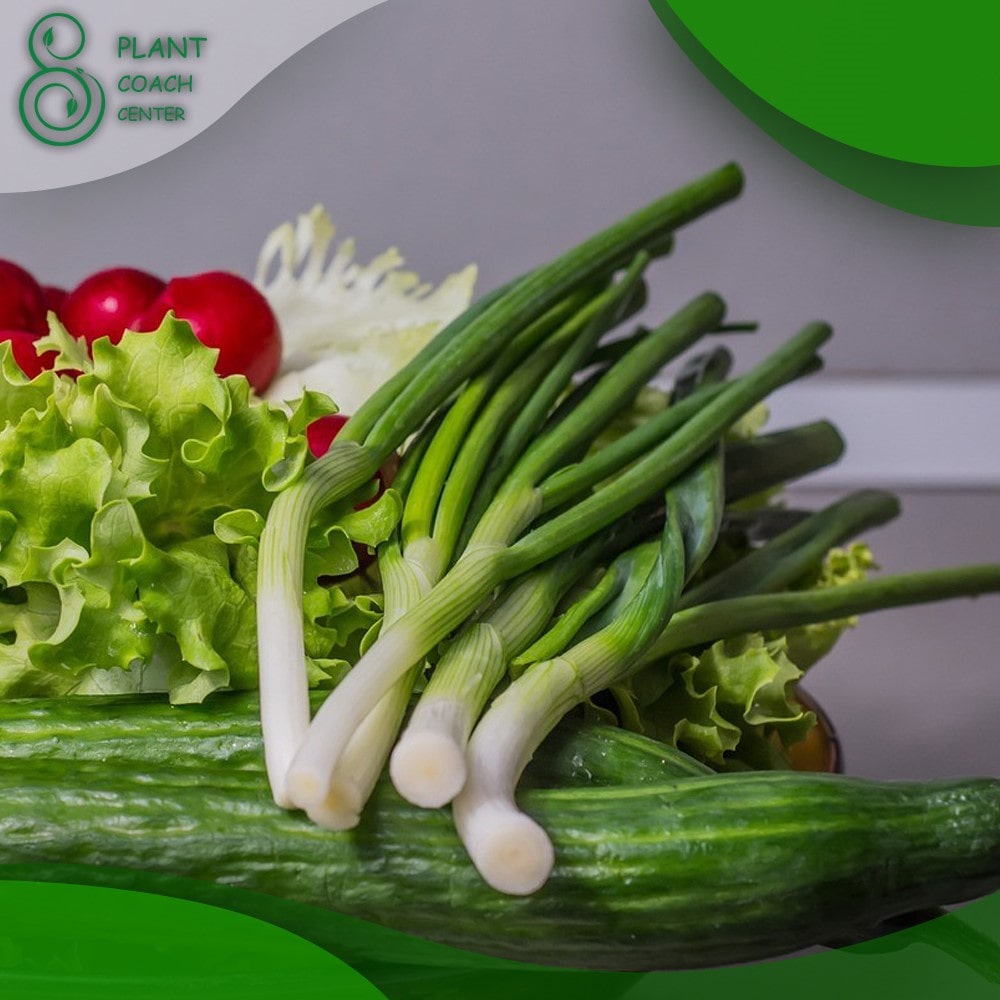When to Plant Spring Onions
Welcome to the comprehensive guide on planting spring onions! Spring onions, also known as scallions or green onions, are not only delicious but also a versatile addition to any garden. Whether you are an experienced gardener or just starting your green thumb journey, understanding the optimal planting time for spring onions is crucial for a successful harvest.
In this guide, we will delve into the world of spring onions, exploring their nutritional benefits, culinary uses, and various varieties. We will then explore the factors that influence the planting time for spring onions, such as climate, temperature, and day length. By understanding these factors, you can determine the ideal planting time for your specific region and ensure the best conditions for your spring onion crop.
Throughout this article, we will provide you with practical tips and techniques for preparing, planting, and caring for spring onions. From starting seeds indoors to direct sowing in the garden, we will cover it all. Additionally, we will discuss essential aspects of spring onion care, including watering practices, fertilization, pest and disease management, and strategies for extending the growing season.
As we journey through this guide, remember that gardening is a delightful and rewarding experience. The information provided here aims to empower you with the knowledge and tools necessary to cultivate healthy spring onions and enjoy the bountiful harvests they offer.
Remember, for personalized guidance and expert advice on spring onion planting and care, visit [PlantCoachCenter.com] (https://www.plantcoachcenter.com), where our plant coaching experts are ready to assist you.
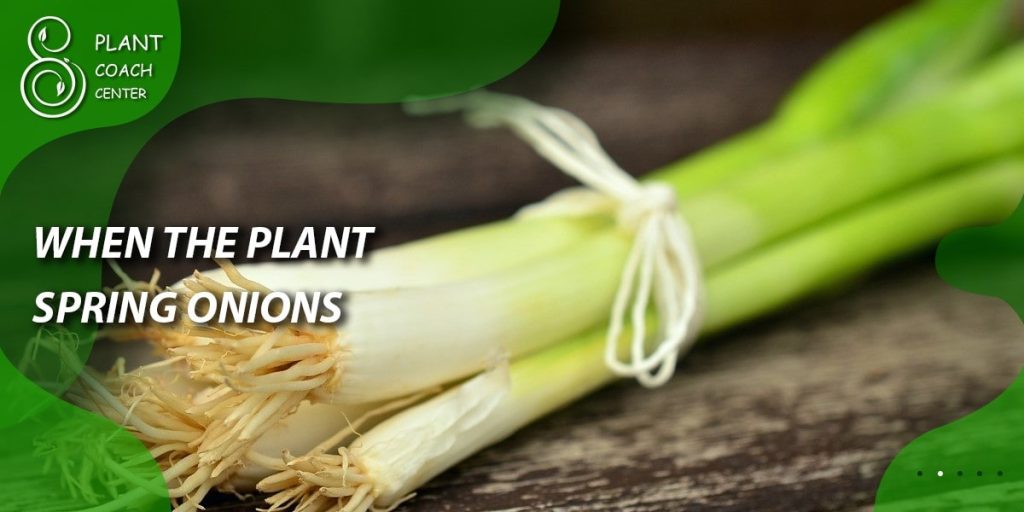
Understanding Spring Onions
Spring onions, also known as scallions or green onions, are members of the Allium family, scientifically known as Allium fistulosum. These versatile and flavorful vegetables are widely used in various cuisines around the world. Before diving into the planting specifics, let’s explore the characteristics, nutritional benefits, and culinary uses of spring onions.
- Introduction to Spring Onions (Allium fistulosum)
Spring onions are characterized by long, slender green stems and small white bulbs. Unlike regular onions, spring onions are harvested before their bulbs fully develop, resulting in a milder flavor profile. The entire plant, from the green tops to the white bulbs, is edible and imparts a distinct onion-like taste to dishes.
- Nutritional Benefits and Culinary Uses of Spring Onions
Spring onions pack a nutritional punch, providing an array of essential vitamins and minerals. They are particularly rich in vitamins K and C, which contribute to bone health, blood clotting, and immune function. Additionally, spring onions contain antioxidants that help combat harmful free radicals in the body.
In the culinary world, spring onions offer versatility and enhance the flavor of various dishes. They are commonly used as a garnish, adding a fresh and vibrant element to salads, soups, stir-fries, and omelets. Spring onions can also be pickled, grilled, or sautéed to bring out their unique taste.
- Varieties of Spring Onions and Their Characteristics
Spring onions come in different varieties, each with its unique characteristics and flavor profiles. Here are some popular spring onion varieties:
. “Evergreen White Bunching”: This variety produces long, white stalks with mild onion flavor. It is known for its cold hardiness and is suitable for early spring planting.
. “Red Beard”: These spring onions have attractive red-purple bulbs and mild, sweet flavor. They add a pop of color to culinary creations.
. “Ishikura”: This Japanese variety is prized for its long, slender green stalks and its ability to resist bulbing. It offers a pungent and robust onion flavor.
. “Guardsman”: With its thick white stems and dark green leaves, Guardsman is a popular spring onion variety that delivers a mild and delicate flavor.
When selecting spring onion varieties, consider your climate, desired taste, and culinary preferences. Experimenting with different varieties can add diversity to your garden and kitchen.
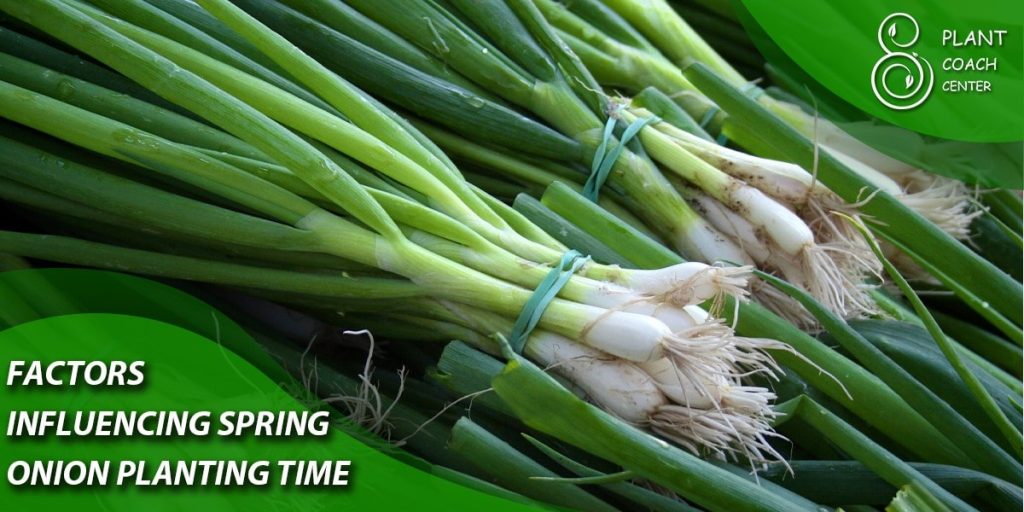
Factors Influencing Spring Onion Planting Time
The ideal planting time for spring onions depends on various factors, including climate, temperature, and day length. Understanding these factors will help you determine the optimal time to sow your spring onion seeds or transplant seedlings. Let’s explore each of these factors in detail.
- Climate and Hardiness Zones for Spring Onions
Spring onions thrive in temperate climates, but they can be grown in a wide range of regions. It’s important to consider the hardiness zones specific to your area to ensure successful cultivation. Consult the USDA Hardiness Zone Map or your regional gardening resources to determine the suitability of spring onions for your climate.
- Temperature Requirements for Spring Onions
Temperature plays a vital role in spring onion growth and development. These cool-season crops prefer moderate temperatures between 55°F (3°C) and 75°F (24°C). They can tolerate light frosts, making them suitable for early spring and fall plantings. However, extreme heat can cause bolting, which leads to premature flowering and reduced bulb development.
- Day Length and Photoperiod Sensitivity of Spring Onions
Spring onions exhibit photoperiod sensitivity, meaning their growth and bulb formation are influenced by day length. Long-day varieties require more daylight hours to trigger bulb development, while short-day varieties form bulbs with fewer daylight hours. Understanding your specific variety’s photoperiod requirements is essential for successful planting.
In general, spring onions are considered short-day plants, meaning they require around 0-2 hours of daylight to initiate bulb formation. Planting short-day varieties in late winter or early spring allows them to receive the necessary amount of daylight for bulb development. Long-day varieties are better suited for fall planting when daylight hours decrease.
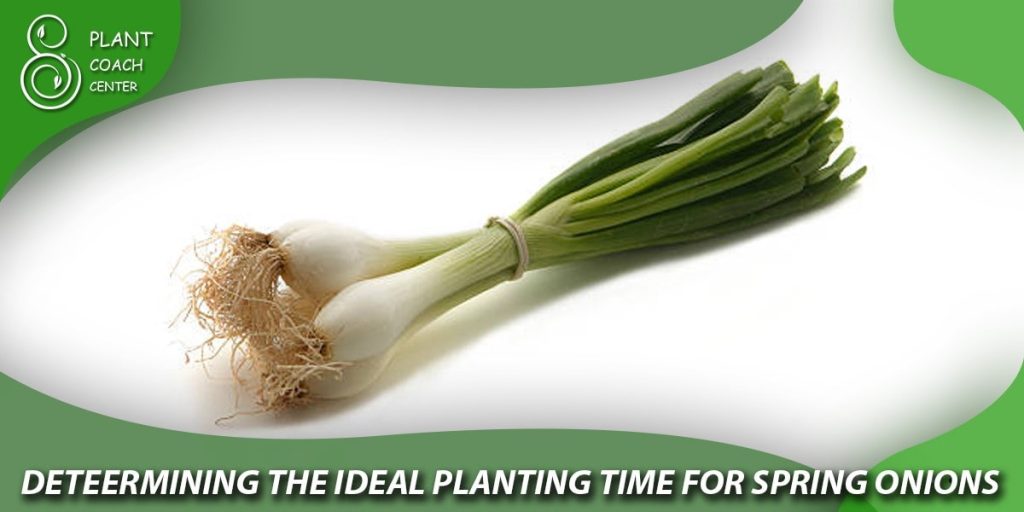
Determining the Ideal Planting Time for Spring Onions
Determining the ideal planting time for spring onions involves considering various factors such as the last spring frost date, growing degree days (GDD), and phenological indicators. By understanding these factors, you can ensure that your spring onions are planted at the optimal time for successful growth and abundant harvests.
- Assessing the Last Spring Frost Date
The last spring frost date is a crucial piece of information when planning your spring onion planting. Spring onions can tolerate light frosts, but they are susceptible to damage from freezing temperatures. Consult your local agricultural extension office or online resources to determine the average last spring frost date for your region. Planting your spring onions a few weeks before this date ensures they have enough time to establish before the risk of frost diminishes.
- Using Growing Degree Days (GDD) for Spring Onions
Growing Degree Days (GDD) is a measure of accumulated heat that helps determine the growth and development of plants. By tracking GDD, you can estimate the appropriate time for planting spring onions. Start by identifying the base temperature for spring onions, usually around 50°F (0°C). Calculate the daily GDD by subtracting the base temperature from the average daily temperature and summing up the values over time.
Once the accumulated GDD reaches a specific threshold for spring onions (typically 50-200 GDD), it indicates that the conditions are suitable for planting.
- Phenological Indicators for Spring Onion Planting
Phenological indicators are signs in nature that can guide your planting decisions. Observing the behavior of plants and natural events can provide valuable insights into the timing of spring onion planting. Look for indicators such as the emergence of certain wildflowers, the blooming of specific tree species, or the activity of local insect populations. These indicators can help you align your planting schedule with the natural rhythms of your environment.

Preparing for Spring Onion Planting
Preparing for spring onion planting involves several essential steps, from selecting high-quality seeds to preparing suitable containers and soil mixes. Taking the time to properly prepare for planting sets the foundation for healthy seedlings and successful cultivation. Let’s explore each step in detail:
- Selecting High-Quality Spring Onion Seeds
When choosing spring onion seeds, opt for reputable seed suppliers or trusted sources. Look for varieties that suit your taste preferences and growing conditions. Ensure that the seeds are fresh and viable by checking the expiration date and any germination rate information provided on the seed packet. High-quality seeds increase the chances of robust germination and healthy plant development.
- Preparing Seed Starting Containers
Starting spring onion seeds indoors allows for controlled germination and early growth. Select shallow containers or trays with drainage holes to prevent waterlogging. You can use seed trays, cell packs, or recycled containers like egg cartons or yogurt cups. Clean and sterilize the containers before use to minimize the risk of disease.
- Creating a Suitable Soil Mix
Prepare a well-draining soil mix for your spring onion seeds. A blend of equal parts compost, peat moss, and vermiculite or perlite works well. Alternatively, you can use a high-quality seed starting mix readily available at garden centers. Ensure the soil mix is moist but not overly wet before sowing the seeds.
- Sowing Spring Onion Seeds
Sow the spring onion seeds evenly across the soil surface, following the planting depth instructions provided on the seed packet. Typically, spring onion seeds are sown at a depth of ¼ to ½ inch (6 to 2 mm). Gently press the seeds into the soil but avoid burying them too deeply. Cover the seeds lightly with a thin layer of soil or vermiculite.
- Providing Optimal Germination Conditions
To promote germination, ensure the seeds receive the right conditions. Place the containers in a warm location with temperatures between 60°F (5°C) and 75°F (24°C). Maintain consistent moisture in the soil by misting it or using a plastic dome or plastic wrap to create a mini greenhouse effect. Check the soil regularly and water when it feels slightly dry to the touch.
- Transplanting Seedlings Outdoors
Once the seedlings have developed a few sets of true leaves and the threat of frost has passed, they are ready for transplanting outdoors. Harden off the seedlings by gradually exposing them to outdoor conditions over a period of 7 to 0 days. Choose a sunny location with well-draining soil for transplanting. Space the seedlings according to the recommended spacing for your chosen spring onion variety.

Direct Sowing Spring Onion Seeds in the Garden
Direct sowing spring onion seeds in the garden is an alternative method to starting seeds indoors. It eliminates the need for transplanting and can be a convenient option, especially for small-scale gardens or when the weather conditions are favorable for direct planting. Here’s a step-by-step guide to direct sow spring onion seeds:
- Site Selection and Soil Preparation
Choose a sunny location in your garden with well-draining soil. Spring onions prefer fertile soil rich in organic matter. Before sowing, prepare the soil by removing any weeds or debris and loosening it with a garden fork or tiller. Incorporate compost or well-rotted manure to improve soil fertility.
- Sowing Spring Onion Seeds
Make shallow furrows in the prepared soil, approximately ¼ to ½ inch (6 to 2 mm) deep, using a garden hoe or your finger. Space the furrows according to the recommended spacing for your chosen spring onion variety, usually around 4 to 6 inches (0 to 5 cm) apart. Sow the seeds thinly and evenly along the furrows, aiming for a spacing of about ½ inch ( cm) between the seeds. Cover the seeds with soil and gently firm it down.
- Watering and Care
After sowing the seeds, water the area gently but thoroughly to ensure good seed-to-soil contact. Continue to water the soil regularly to keep it consistently moist, but avoid overwatering, as excessive moisture can lead to rotting. As the seedlings emerge, thin them out if necessary, leaving the strongest ones spaced appropriately according to the variety’s recommended spacing.
- Weed Control and Mulching
Keep the area around the spring onion seedlings free from weeds, as weeds can compete for nutrients and water. Regularly remove any weeds that appear near the plants. Consider applying a layer of organic mulch, such as straw or wood chips, around the seedlings to suppress weed growth, retain moisture, and regulate soil temperature.
- Harvesting Spring Onions
Spring onions can be harvested at different stages of growth, depending on your preference. You can harvest them as young and tender scallions by pulling them from the ground when they reach about 6 to 8 inches (5 to 20 cm) in height and have developed a bulb-like base. Alternatively, you can allow them to grow further to develop larger bulbs and stronger flavors.
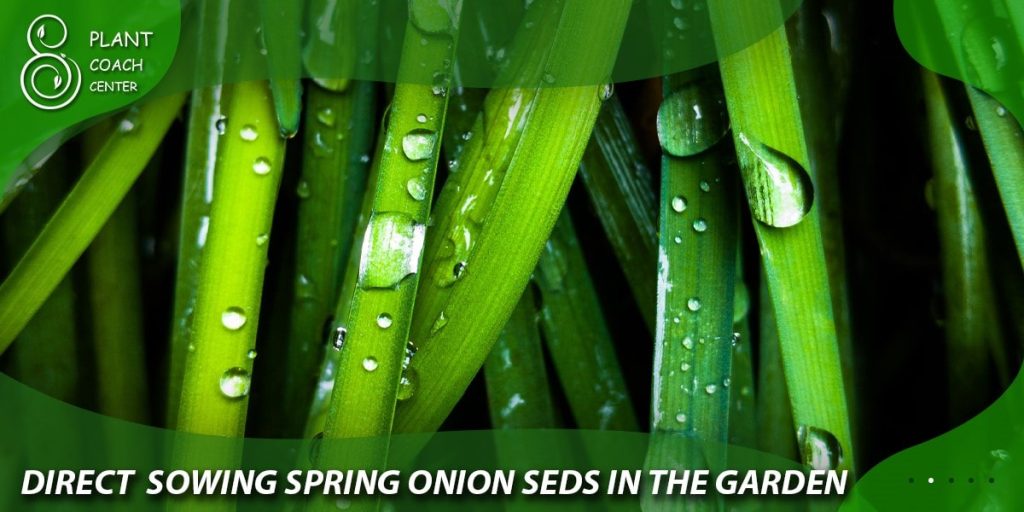
Direct Sowing Spring Onion Seeds in the Garden
Direct sowing spring onion seeds in the garden is an alternative method to starting seeds indoors. It eliminates the need for transplanting and can be a convenient option, especially for small-scale gardens or when the weather conditions are favorable for direct planting. Here’s a step-by-step guide to direct sow spring onion seeds:
- Site Selection and Soil Preparation
Choose a sunny location in your garden with well-draining soil. Spring onions prefer fertile soil rich in organic matter. Before sowing, prepare the soil by removing any weeds or debris and loosening it with a garden fork or tiller. Incorporate compost or well-rotted manure to improve soil fertility.
- Sowing Spring Onion Seeds
Make shallow furrows in the prepared soil, approximately ¼ to ½ inch (6 to 2 mm) deep, using a garden hoe or your finger. Space the furrows according to the recommended spacing for your chosen spring onion variety, usually around 4 to 6 inches (0 to 5 cm) apart. Sow the seeds thinly and evenly along the furrows, aiming for a spacing of about ½ inch ( cm) between the seeds. Cover the seeds with soil and gently firm it down.
- Watering and Care
After sowing the seeds, water the area gently but thoroughly to ensure good seed-to-soil contact. Continue to water the soil regularly to keep it consistently moist, but avoid overwatering, as excessive moisture can lead to rotting. As the seedlings emerge, thin them out if necessary, leaving the strongest ones spaced appropriately according to the variety’s recommended spacing.
- Weed Control and Mulching
Keep the area around the spring onion seedlings free from weeds, as weeds can compete for nutrients and water. Regularly remove any weeds that appear near the plants. Consider applying a layer of organic mulch, such as straw or wood chips, around the seedlings to suppress weed growth, retain moisture, and regulate soil temperature.
- Harvesting Spring Onions
Spring onions can be harvested at different stages of growth, depending on your preference. You can harvest them as young and tender scallions by pulling them from the ground when they reach about 6 to 8 inches (5 to 20 cm) in height and have developed a bulb-like base. Alternatively, you can allow them to grow further to develop larger bulbs and stronger flavors.
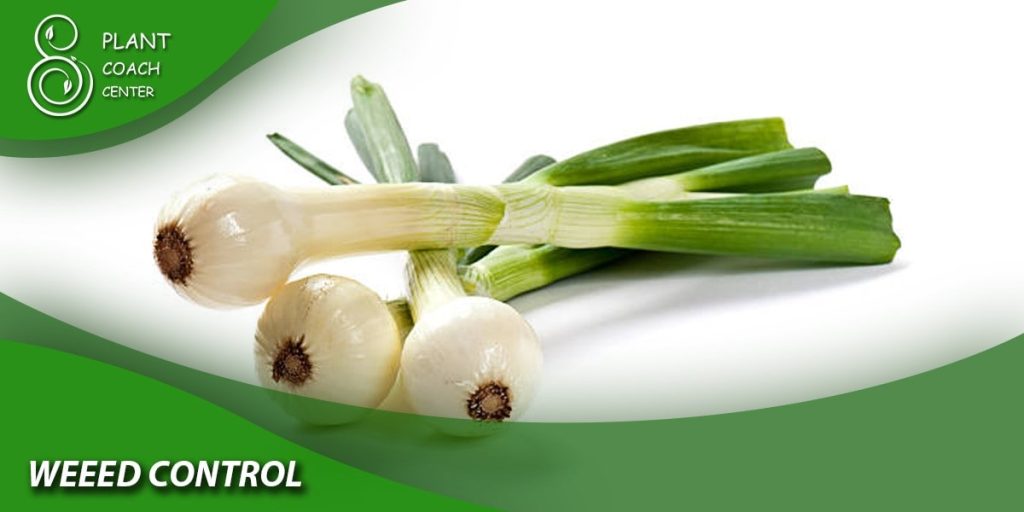
Conclusion
Spring onions are a versatile and flavorful addition to any garden and kitchen. With their mild onion flavor and various culinary uses, they can enhance a wide range of dishes. By following the planting and care guidelines, you can successfully grow your own spring onions and enjoy a bountiful harvest.
Remember to select the appropriate variety for your taste preferences and growing conditions. Whether you choose White Lisbon, Ishikura Bunching Onion, or any other variety, each brings its unique characteristics to your garden.
Proper planting, regular watering, and providing adequate sunlight will ensure healthy growth and development of your spring onions. Harvest them at the desired stage, whether as scallions or mature bulbs, and store them properly for short-term or long-term use.
If you ever need guidance or have specific questions about spring onion cultivation, storage, usage, or companion planting, remember to visit [PlantCoachCenter.com] (https://www.plantcoachcenter.com). Our plant coaching experts are ready to provide personalized advice and support to help you succeed in your gardening endeavors.
Enjoy the process of growing spring onions and savor the satisfaction of harvesting and using your homegrown produce in delicious meals. Happy gardening!


